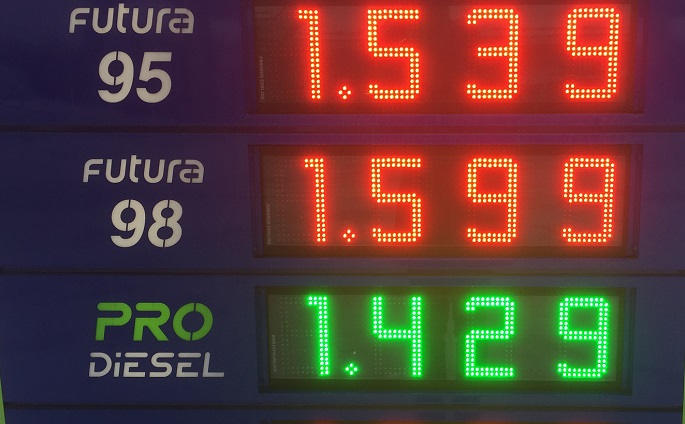Oil prices gain for 4 consecutive weeks
Published : 08 Oct 2018, 01:30
Updated : 08 Oct 2018, 02:42
Oil prices recorded fourth weekly gain in a row with the reports of the declining Iranian crude oil exports ahead of the sanctions on Iran by the United States early next month.
The price of West Texas Intermediate (WTI) for November and Brent for December delivery increased by 1.5 and 1.7 percent, respectively, in the week ending Oct. 5. At the end of the week, WTI and Brent settled at 74.34 and 84.16 U.S. dollars per barrel, respectively.
On Monday, WTI and Brent prices rallied and settled at the highest prices of almost four years. The preliminary trade deal that was signed between the United States and Canada was a big boost for the oil prices.
Moreover, the reports about the declining Iranian crude oil exports and the news about the possibility of 100-dollar oil in near future were the factors that strengthened the bullish sentiment in the oil markets.
On Monday, WTI and Brent increased by 2.74 and 2.48 percent to settle at 75.30 and 85.98 dollars per barrel, respectively. The last time when oil prices reached those levels was in November 2014.
On Wednesday, the oil prices continued its upward trend despite the fact that the U.S. Energy Information Administration (EIA) reported the largest weekly build in the U.S. commercial inventories for the week ending Sept. 28. The market was still highly concerned with a potential supply deficit due to the lower Iranian crude oil exports.
EIA reported a build of 7.98 million barrels in commercial crude oil inventories which was much larger than the market's expectation of a build of 1.1 million barrels.
Meanwhile, U.S. import of crude oil increased by 163,000 barrels per day from the previous week's levels to 7.97 million barrels per day. Crude oil exports decreased by 917,000 barrels per day from the previous week's levels to 1.72 million barrels per day.
According to EIA, weekly estimate of the U.S. oil production remained level at 11.1 million barrels per day.
EIA reported a draw of 1.75 million barrels in distillates inventory which was very close to the market's expectation. It also reported a draw of 459,000 barrels in total gasoline inventories, while the market was expecting a build of 1.2 million barrels.
EIA also reported that crude oil input to refineries increased by 77,000 barrels per day to 16.59 million barrels per day. The refinery utilization has been much lower in the last two weeks and it is seasonal as some major refineries started their maintenance projects after the high demand season.
Normally, the crude oil inventories start building up during the maintenance season as the utilization rate of the refineries decline and the inventories of the oil products come down.
Although the analysts saw the significant build in the commercial crude oil inventories as a major bearish factor, the oil prices kept rallying with the support of the news about the declining Iranian crude oil exports.
After the EIA's weekly petroleum status report, WTI and Brent prices moved significantly higher and settled 1.72 percent and 1.87 percent higher, respectively, on Wednesday.
Some analysts believe that over 1 million barrels per day of Iranian crude oil exports would go offline due to the looming sanctions. However, some experts doubt it.
Samir Madani, co-founder of TankerTrackers, a platform that tracks the crude oil trade, told Xinhua "everyone is comparing the current levels of Iranian crude oil exports with its peak levels in April. However, that is not a healthy comparison. Taking the annual average is a more accurate base point to compare."
He said, "According to our preliminary data, Iran' s crude oil and condensates exports were 1.81 million barrels per day in September," but actually the number may be "over 2 million barrels per day, higher than its August levels. "
On Thursday, the oil prices took a steep dive after the Russian and Saudi energy officials informed the markets about their record-high outputs. WTI and Brent prices went through a correction and settled 2.43 percent and 1.80 percent lower, respectively.
Anas Alhajji, an energy economist based in Dallas, Texas, told Xinhua that "lack of unified definitions and circular information are contributing to the disconnect between oil prices and market realities."
He said, "If oil prices were truly heading toward 100 dollars per barrel, we would have seen a response from several OPEC members anyway, regardless of U.S. President (Donald) Trump's wishes."
On Friday, WTI and Brent prices settled 0.44 percent and 0.65 percent lower, respectively. The price differential between WTI and Brent contracts slightly widened and settled at 9.82 dollars at end of the week.
With the economic engines of the world's leading industrial countries fueled by the direction of oil prices, the often-unstable politics of the Middle East have long been watched closely by world leaders from Beijing to Washington to Moscow.
As oil prices continue to rise -- and with the energy-dependent economies of the Persian Gulf undergoing dramatic political and social change -- several international experts gathered at Houston's Rice University on Wednesday to share their thoughts on the latest developments and ongoing issues in the Persian Gulf.
Until recently Saudi Arabia had long been the world's leader in oil production, with Saudi wealth amassed as its oil fields produced millions of barrels of oil a day. The U.S. surpassed Saudi Arabia and became the largest oil producer in 2017, pumping 14.46 million barrels per day, or 15 percent of the world's production, according to the U.S. Energy Information Administration (EIA). Saudi Arabia dropped to second at 12.08 million barrels a day, or 13 percent.


